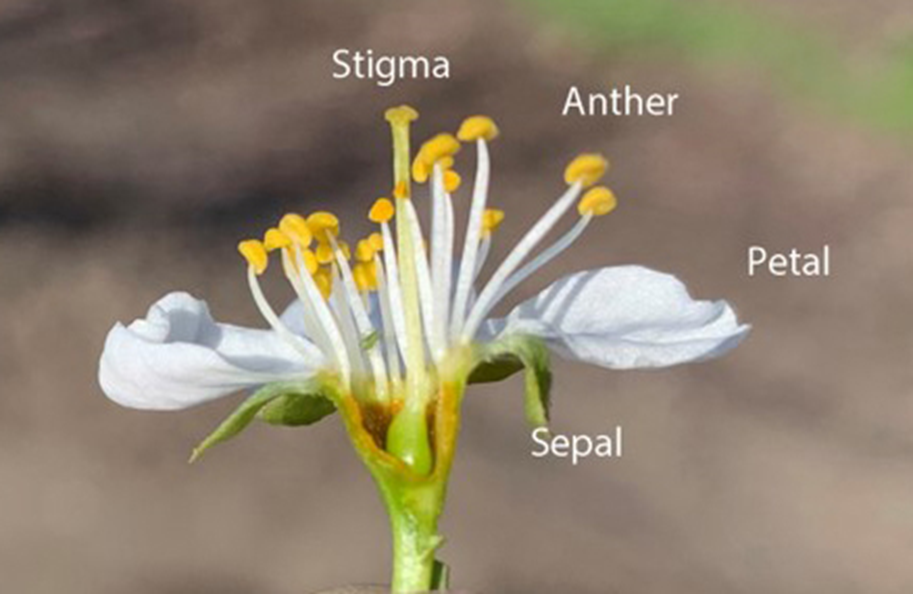Franz Niederholzer, UCCE Farm Advisor, Colusa, Sutter/Yuba Counties
Crop failure in years with extreme bloom weather (cool or hot) challenges successful prune growing in California. A new bloom weather model is a good starting point to predicting crop potential and, eventually, managing risk of crop failure.
The simple answer
1) A week of extended cool (<60oF daily max temperatures), rainy weather before and after full bloom or 2) very hot (>80oF) temperatures at full bloom to two days after full bloom with cool temperatures 4 to 7 days before full bloom or 3 to 6 days after full bloom produced multiple prune crop failures since 2004.
The full story
Crop failure lowers grower income and reduces world market position for California prunes, further lowering grower returns. Understanding the how/why of prune crop failure and developing management practices to maintain production are critical steps to economically viable prune production in California.
In the last 17 years, prune crop failures in California (statewide or regionally) occurred in 2004, 2005, 2007, 2013, and 2020. Unusually cool or hot weather during bloom in those years coincided with low production (a state average of less than 1.5 dry ton/acre). In all these years, full bloom occurred before March 15.
Observations in prune orchards following extreme bloom weather showed similar patterns of fruit development and drop. Fruit grew to pea size in the first 2-3 weeks after full bloom and then yellowed and fell off the tree. These consistent observations suggests that crop failures were due to problems with processes in flowers, not external conditions such as pollination/bee activity.
Setting a prune (or other stone fruit) requires successful completion of a series of carefully timed events. Once prune pollen arrives on the flower stigma on honeybees and/or other pollinators, the pollen grain must germinate and grow down the style to the ovary at a time that the ovule is viable to properly fertilize the ovary (see image at the end of this article).
Temperature influences the rate of these processes in flowers. UC Davis research (funded by the California Prune Board) found that ‘Improved French’ pollen tube growth is slow in cool weather, speeds up as temperature increases to a maximum at about 75oF and then slows with further temperature increase. Researchers were not able to determine how temperature influences ovary viability in ‘Improved French’ prune, but, in other prune varieties, high temperatures reduces ovule viability. If the ovule is inviable when the pollen arrives at the base of the flower, no fruit is set.
UC Farm Advisors (funded by the California Prune Board) tracked bloom temperatures and flower development (% open flowers) for 15 years from Red Bluff to Madera to build a model predicting fruit set based on bloom temperatures found that in orchards that bloom before March 15, temperatures at 7-4 days before full bloom, full bloom to two days after full bloom, and three to six days after full bloom all influence fruit set. Consistently cool weather can reduce set (as in 2016) but most crop failures since 2004 have been associated with cool temperatures early and late in bloom with high temps at or just after full bloom. A model was developed in 2022 to estimate percent fruit set from full bloom date and max daily temps for a week ahead and after that dat. The model is being field tested. Model inputs are the date of full bloom (80% open flowers) and maximum temperatures for a week before and after full bloom.
What can growers do if high temperatures are forecast for full bloom or a few days afterwards? Growers with sprinkler irrigation can cool the orchard by 1-2oF by running water when air temperatures exceed 75oF. To date, no UC trials with a range of spray materials (nutrients, plant growth regulators, etc.) improved prune fruit set under hot bloom weather. Orchards thinned the year before should have more return bloom compared to unthinned orchards, and therefore more crop if bloom conditions favor low fruit set.

Prune flower cut-away to expose the ovule (tiny fruit at the base of the style – the flower part topped with the stigma). Pollen moves from the anthers to the stigma with bee activity. On the stigma, the pollen germinates and grow down to the ovary. If a pollen tube arrives at a healthy ovule, a fruit can be set.
*****************************************************
*80% open flowers is considered “full bloom”. This timing might be a few days earlier than traditional considered full bloom.


Leave a Reply